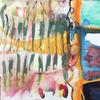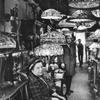The Nefertiti 3D Scan Scandal Highlights Museum Data Security
- March 10, 2016 19:38

Museums around the world have increasingly opened up their digital archives to share collections with the public. Art images can be downloaded, and browsed on Google Art Project or museums' websites. Yet, 3D scans of sculpture, objects and painting are largely safe-guarded. Last week guerrilla-scanning of museum objects became a hot topic.
Cosmo Wenman, a 3D designer, writes on his blog:
The New York Times’ March 1, 2016 story “Swiping a Priceless Antiquity … With a Scanner and a 3-D Printer” by Charly Wilder tells how two German artists made a surreptitious, unauthorized 3D scan of the iconic bust of Nefertiti in the Neues Museum in Berlin.
The artists, Nora Al-Badri and Jan Nikolai Nelles, make a case for repatriating artifacts to their native countries and use Nefertiti as their focal point. They also point out that the Neues Museum has made its own high-quality 3D scan of the bust, and that the museum should share that data with the public. As a protest, they released their own scan to the public, and the quality of their scan is extraordinary.
Too extraordinary, say doubters of the artists' story, noting that their modified Microsoft Kinect scanner was not capable of such a precise scan. Wenman calls the artists' tale of secretly scanning the Nefertiti bust a mystery-shrouded hoax. If the museum's own scan was used, the possibility of a hack or data breach adds new intrigue to the story. Wenman argues, "I know from first-hand experience that people want this data, and want to put it to use, and as I explained to LACMA in 2014, they will get it, one way or another. When museums refuse to provide it, the public is left in the dark and is open to having bogus or uncertain data foisted upon it."
Public access to high quality scans of museum objects may sound unlikely. Yet already onboard with it is the Smithsonian which launched a project in 2013 allowing for some 3D scanned objects (like a cast of Abe Lincoln's face) to be downloaded and printed as models.
3D scans can also be museum money-makers. Fujifilm with the Van Gogh Museum sell 3D scanned Van Gogh replicas for upwards of $30,000.




















